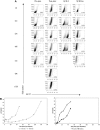Rapid expression of human immunodeficiency virus following activation of latently infected cells
- PMID: 16415036
- PMCID: PMC1346949
- DOI: 10.1128/JVI.80.3.1599-1603.2006
Rapid expression of human immunodeficiency virus following activation of latently infected cells
Abstract
The host cell activation state impacts the nature of human immunodeficiency virus infection. Activated cells facilitate productive infections; quiescent cells enable the virus to enter a latent state, the major obstacle to viral clearance. We wanted to understand how these differences affected viral gene expression. In quiescent cells activated prior to infection, viral RNA was seen 12 h postinfection; when cells were stimulated postinfection, viral RNA was not seen until 36 h postinfection. Up-regulation of viral RNA in latently infected cells occurred within 2 h poststimulation. This hierarchy also held true for viral protein production. These results may explain the rapid reemergence of viremia following termination of therapy.
Figures



References
-
- Aldrovandi, G. M., G. Feuer, L. Gao, B. Jamieson, M. Kristeva, I. S. Chen, and J. A. Zack. 1993. The SCID-hu mouse as a model for HIV-1 infection. Nature 363:732-736. - PubMed
-
- Brooks, D. G., S. G. Kitchen, C. M. Kitchen, D. D. Scripture-Adams, and J. A. Zack. 2001. Generation of HIV latency during thymopoiesis. Nat. Med. 7:459-464. - PubMed
-
- Chiu, Y. L., V. B. Soros, J. F. Kreisberg, K. Stopak, W. Yonemoto, and W. C. Greene. 2005. Cellular APOBEC3G restricts HIV-1 infection in resting CD4+ T cells. Nature 435:108-114. - PubMed
Publication types
MeSH terms
Substances
Grants and funding
LinkOut - more resources
Full Text Sources
Other Literature Sources

